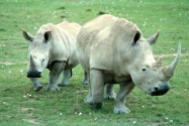INTERVIEW-Sudanese rebels threaten rare Congolese rhino
By David Lewis
 KINSHASA, May 11 (Reuters) – Armed Sudanese rebels have driven the rare northern white rhinos to near extinction after they stepped up poaching in northern Congo, a conservationist told Reuters on Tuesday.
KINSHASA, May 11 (Reuters) – Armed Sudanese rebels have driven the rare northern white rhinos to near extinction after they stepped up poaching in northern Congo, a conservationist told Reuters on Tuesday.
If left unchecked, the rebels could wipe the rhinos out “in a matter of months,” said Henri Paul Eloma, the coordinator of a project to protect wildlife from the effects of war in Congo run by the U.N.’s cultural heritage body UNESCO.
Eloma said the world’s 27 remaining wild northern white rhinos all lived in Congo’s Garamba National Park, on the northern border with Sudan. Rebels were gunning down both the rhinos and elephants with automatic weapons for their valuable horns and tusks, he said.
“If we don’t control the SPLA, at this rate, they will exterminate all the rhinos that are left,” he said in an interview in the Congolese capital Kinshasa.
“This is a subspecies that doesn’t exist anywhere in the world so they will soon be extinct in the wild,” he added.
The rebels had recently adopted new tactics to ensure they are not caught. They began using horses and donkeys to cart rhino horns and elephant tusks out of the park quickly rather than setting up camp to smoke and trade bushmeat, Eloma said.
“As it is, the guards don’t have enough weapons and ammunition to fight the SPLA. We just hope that the U.S. can put pressure on (SPLA leader John) Garang so that his fighters can be more disciplined and respect the world heritage,” Eloma said.
The United States has been involved in efforts to reach a peace deal between Sudan’s government and the SPLA, the Sudanese People’s Liberation Army, which has been fighting for 20 years for autonomy for the mainly Christian and animist south.
NEW REBEL INCURSIONS
Other conservationists say fighters from a separate conflict in northern Sudan are now also coming into Garamba to poach.
Once out of the park, the poachers are thought to head to the southern Sudanese town of Yambio, where traders buy ivory and rhino horn from the Congo and Central African Republic.
Congo is emerging from a five-year war that involved six neighboring countries, displaced millions and killed at least three million people, mostly from starvation and disease.
Through UNESCO’s Biodiversity Conservation in Conflict Areas, a pilot project aimed at preserving the world’s natural heritage that is threatened by war, much wildlife survived.
“The project has been successful in that we have managed to maintain the ecological capital and each site was able to protect its species,” Eloma said.
But the crisis in Garamba highlights the risks that Congo’s wildlife faces from conflict in neighboring countries and continued pockets of fighting in the east of the country.
